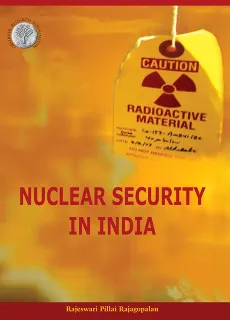The security of nuclear and radiological materials has been a global concern since the end of the Cold War and the disintegration of the Soviet Union in 1991. The threat gained greater traction after the 9/11 terror attacks because of fears that terrorists might acquire such material. The International Atomic Energy Agency’s Incident and Trafficking Database states that between January 1993 and December 2013, there were a total of 2,477 incidents of theft and other unauthorised activities involving nuclear and radioactive material notified to the Agency. In 2013 alone, there were 146 incidents confirmed in the IAEA database. Thus, there is a renewed effort to strengthen old international rules and regimes as well as to establish new mechanisms. Three nuclear security summits held so far, just on this issue, is recognition of this renewed importance.
India has for long been a victim of terrorism. It has suffered everything from left-wing extremism to separatist insurgency and state-sponsored cross-border terrorism. The Mumbai terror attack offers sufficient evidence of the inclination and capacity of terrorist groups to carry out commando-style attacks on key targets within Indian territory. With support from Rawalpindi, a terrorist attack on an Indian nuclear installation remains a clear and present danger.
Given the context, we present a comprehensive threat analysis of the nuclear security situation in India, the measures adopted by the Indian nuclear and security establishments in response, strengths and weaknesses and an overview of the best practices around the world in order to gauge India’s nuclear security efforts. The study focuses on potential incidents involving the detonation of a nuclear explosive or use of weaponised nuclear devices, radiological dispersal devices (dirty bomb), and sabotage as well as insider threats to sensitive facilities. While the study focuses largely on the security aspects, the safety of India’s nuclear and radiological materials and institutions is also taken into account, considering the existing synergy between the safety and security practices in the nuclear context.
The key findings of the study are:
(i) India, like other nuclear powers, faces serious threats in the realm of nuclear security. Terrorist organisations operating out of Pakistan have declared interest in acquiring some kind of nuclear capabilities and the threat of nuclear terrorism, including detonation of a radiological dispersal device or an aerial attack on a nuclear facility, cannot be ruled out.
(ii) Threat perceptions among security agencies in various states in India present a mixed picture. Even when some states are aware of threats and vulnerabilities, it does not translate into streamlined policies or proper financial and human resource allocation because other more immediate concerns get in the way. Agencies in Andhra Pradesh, to give only one example, appear quite aware of such threats but seem to be overwhelmed by more immediate concerns emanating from Maoist insurgents in the state.
(iii) Cyber attacks may be as important a threat to India’s nuclear facilities as a direct physical assault. Use of cyber networks to attack a nuclear facility could render ineffective many current safety and security mechanisms. Indian agencies need to pay greater attention to new technical innovations that are available to tackle vulnerabilities in the cyber realm.
(iv) On-site security and safety measures, including during the disposal of nuclear and radiological materials at the end of their life cycles, have been made more stringent. Use of technology to minimise human element both to avoid possible errors as well as to deal with insider threats has been increased.
(v) Unlike other recent evaluations, we assess that India’s nuclear security measures are comparable to best practices globally. Two concepts that stand out in particular are the personnel reliability programme (PRP) and the defence in depth principle applied in India’s nuclear facilities. Stringent background checks undertaken as part of PRP are critical in mitigating the insider threat. Indian nuclear plants have also inculcated the principle of defence in depth which includes a layered system of security, thus strengthening physical protection systems. The layered security system also requires an adversary to overcome or circumvent multiple obstacles that helps delay penetration and complements access control.
(vi) One of the challenges facing India’s agencies tasked with nuclear security will be their ability to respond quickly and effectively and in a coordinated manner during emergencies. Though not unique to India, the population density in India’s urban centres increases the vulnerabilities and the possible casualty levels in the event of an attack. The Department of Atomic Energy is beginning to realise the need for integrated drills involving both security within the perimeter and outside operating in unison. Already the number of such drills has increased and is expected to increase in frequency and number further.
(vii) As India attempts to integrate with the international nuclear community, cooperation, both with individual countries and international organisations, is a key aspect. This would entail more openness and transparency in India’s nuclear security regime. A more controlled-transparency approach and a more proactive engagement outlining India’s broad strategy in the area of nuclear security can have multiple benefits for India.
The views expressed above belong to the author(s). ORF research and analyses now available on Telegram! Click here to access our curated content — blogs, longforms and interviews.

 PDF Download
PDF Download



 PREV
PREV


